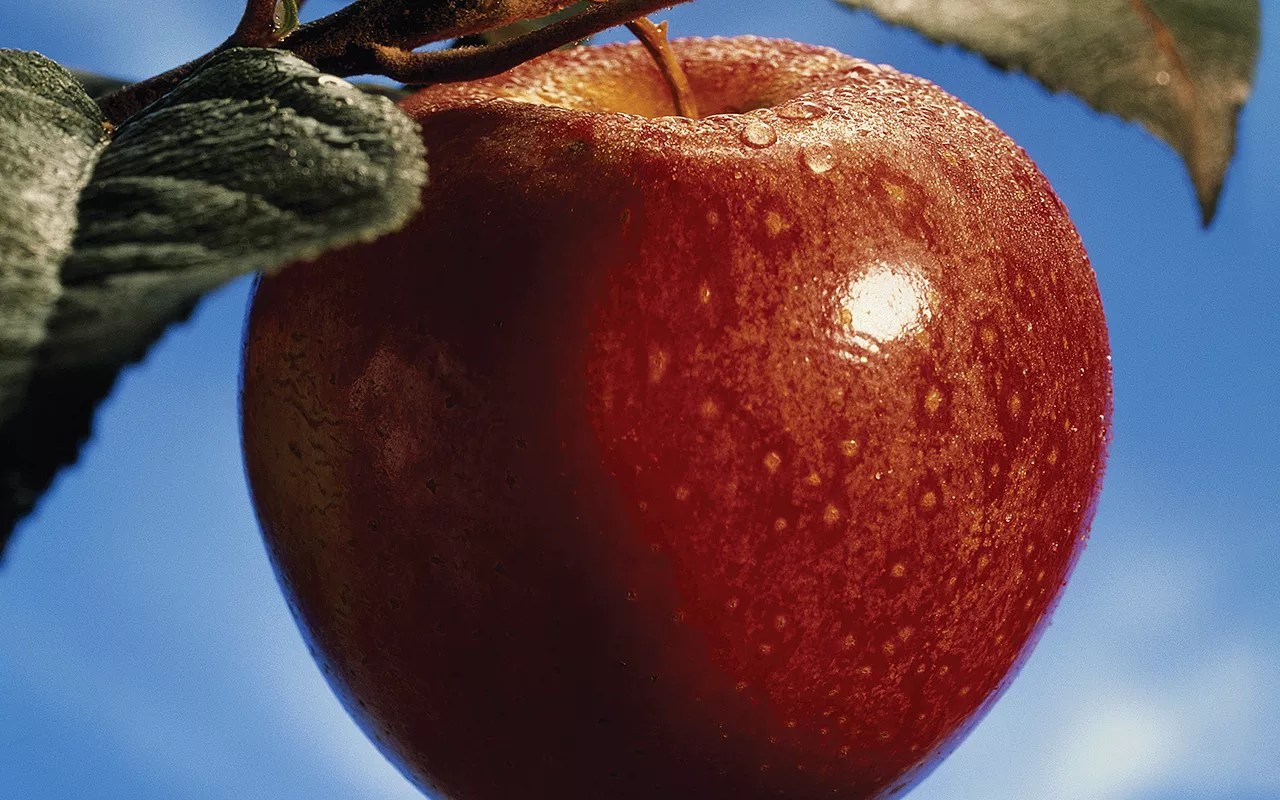
Getty Images

Audio By Carbonatix
Katharine Suding’s children arrived home one day in 2017 with a small bag of apples from an unkempt old apple tree that sat in the middle of a field near her home in Louisville. Suding, an ecology professor at the University of Colorado Boulder who moved here from Berkeley about ten years ago, would often walk along the bike path that weaves through the field, appreciating the view of the Boulder Flatirons to the northwest. She had seen the tree before, but never thought much about it.
Until the apples her children brought home made her curious, and she paid the tree a visit.
It looked more like a large bush than a tree, its fruit-covered branches bent over and stretching to the ground – clearly uncared for, though still cared about. Those branches formed the roof and walls of a natural fort, marked with a welcome sign placed near an opening in the canopy by neighborhood kids.
“I can’t believe that there’s a tree that’s not being watered, not being taken care of, and producing a ton of fruit,” Suding recalls thinking. “This is crazy that this tree can live.” The trunk was cracked and hollow, so determining its age by counting rings was impossible. Based on the diameter of the trunk, though, she estimated that the tree was about a hundred years old.
And it wasn’t the only interesting old tree in the area. As she went about her daily life, Suding began to notice more and more strange apple trees around Boulder County. “I thought they were totally, really unusual,” she says.
She started looking into the history of the tree near her house. At the Louisville Historical Museum, she found evidence to back up her estimate of the tree’s age. “We found a map of the town from the 1920s which showed the different landowners,” she notes. “This area was owned by a family in town that came from Wisconsin.”
Since apple trees along the Front Range typically live between 80 and 120 years, her interest in the old trees took on some urgency. That fall, she founded the Boulder Apple Tree Project, an initiative based in CU’s ecology department that’s designed to track down and preserve the trees before they die.
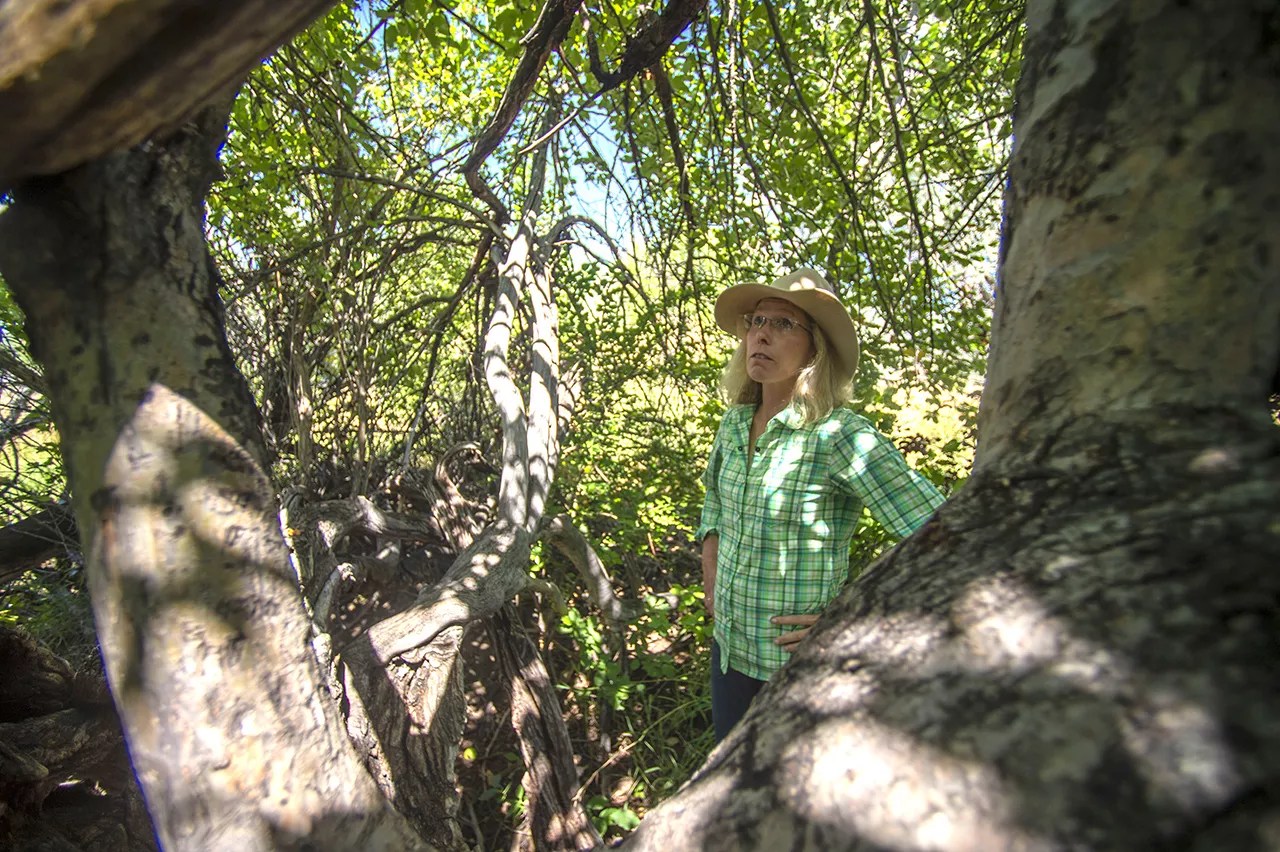
Katharine Suding by the old apple tree that inspired the Boulder Apple Tree Project.
Evan Semón
As the Boulder Apple Tree Project got underway, Suding began gathering local apple enthusiasts – agricultural experts from Boulder Parks & Open Space, people working in the hard-cider business – to identify areas where the project should search for more trees. “We had this huge map of Boulder that we printed out, and they all were in this room with this map, and they were drawing circles – ‘Go here! There’s a good tree here, there’s a good tree here,'” she recalls.
They searched the county, locating trees and putting them in a database that now includes thousands of entries.
But as the database grew, so did questions about the trees’ origin that Suding couldn’t answer. So “I started knocking on doors at the history department in CU,” she says. And she found a history graduate student – Amelia Brackett, who has since graduated – to lead a historical research component of the Boulder Apple Tree Project.
It turned out that most of the trees the project was identifying were among the first ever planted in the area.
“When people moved here, when the first European people came here, you wouldn’t have seen any of these trees,” Suding says, gesturing out to the leafy landscape of north Boulder. “None of these pine trees would be here, hardly any of the cottonwoods.” And definitely not the apple trees.
When settlers began arriving in the mid- to late 1800s, the landscape was “much more arid, so they basically had to plant any of this stuff – for shade, for food. It was one of the first things they did when they tried to establish themselves,” Suding explains.
Since different apple trees produce different kinds of apples – marked by their own flavors and physical characteristics – many homesteaders would bring a small branch of an apple tree from back home and plant the branch to take root as a sapling. This ensured that they could enjoy a taste of home, since most apple trees grown from seeds do not produce good-tasting fruit.
By the late 1800s, Boulder was an all-out apple town and Colorado a major apple-producing state. “Chautauqua was an orchard before [it was] Chautauqua, so there’s old trees there that are really quite special,” Suding says. The nearby towns of Hygiene and Lyons both had major orchard operations; a stretch of road near U.S. 36 going up toward Estes Park is even named “Apple Valley Road.”
But disease, drought and then floods hit Boulder’s apple economy. Prohibition affected it, too. “A lot of the early trees were planted for alcohol,” says Suding, who notes that even trees that didn’t produce good-tasting fruit might make good hard apple cider. The tree she found near her home, for example, produces a “super-tart green apple. Almost certainly it was used for cider.”
And then a certain apple took the country by storm. “There was a real push in the ’30s and ’40s to plant Red Delicious apples,” says Suding. People felt “there was one really good kind of apple, and the rest of them were just no good. So a lot of orchards were cut down or replaced with those, and then we realized a decade later the Red Delicious actually doesn’t do well here.”
“There was a real push in the ’30s and ’40s to plant Red Delicious apples.”
After that, Red Delicious production moved primarily to Washington state. And Colorado’s apple production largely disappeared.
“It seems like people think that if Colorado kept with the types of apples that actually do well in this climate, a lot of the orchards that were once here maybe could have persisted. But we kind of followed the trends – Colorado State at that time was telling people to cut down things. We just didn’t understand how important the diversity and the variety was,” Suding says.
Development was the last nail in the coffin, replacing the orchards of north Boulder with housing. “A lot of times they would cut down most of the trees, but they would leave one or two in the backyards when they were making their subdivisions and the developments in the ’40s and ’50s,” she explains. “So there’s a lot of interesting old trees in that area.
“And the old trees that stayed are just kind of the lucky ones,” she continues. “They’re mostly in people’s backyards or in old orchards that someone kept because they didn’t need [the land]. But there are trees along canals here, or places where it’s pretty amazing that they can just survive. They don’t have to be taken care of; they can survive. It’s impressive when you see an old tree.”
And distressing when you realize what’s been lost. “In the ’20s, there was a state horticulturalist who went around and recorded all the trees that were planted in the different orchard districts…[and kept] really detailed records of all the different varieties,” Suding says. “It’s estimated that there were at least 400 different varieties of apples that were cultivated.”
A hundred years later, she adds, “we can’t find about half of them.”
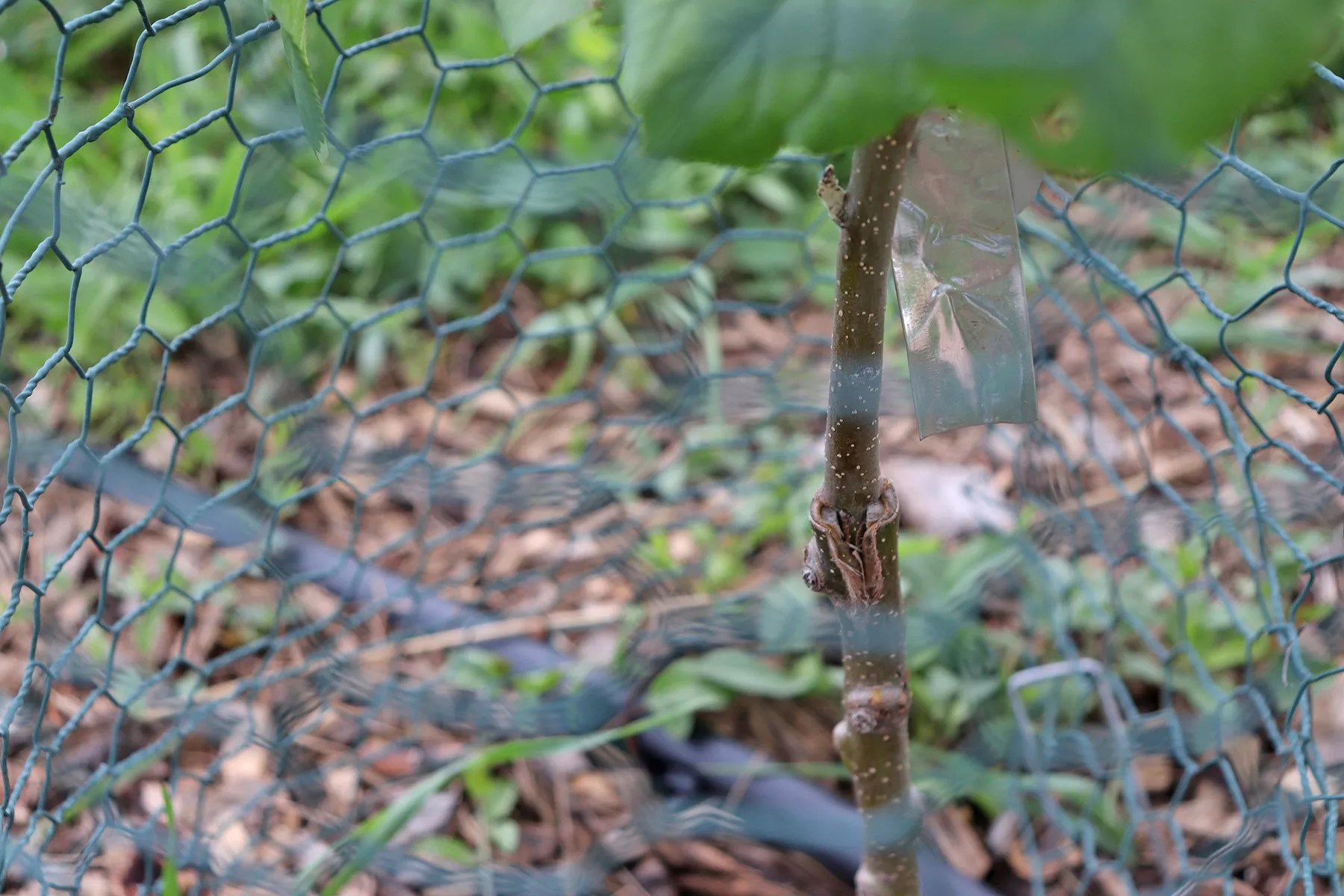
An apple tree cutting that’s been grafted to rootstock.
Benjamin Neufeld
The very first apple trees that produced fruit for human consumption came from Kazakhstan. Nearly all modern apple tree “cultivars” can be traced back to a single ancient ancestor from the Tian Shan Mountains, where apple trees have grown for millions of years, according to the Orchard Project, a similar initiative to the Boulder Apple Tree Project located in the United Kingdom.
Animals that ate the apples from these Kazakh forests likely spread the seeds beyond the region, and the Romans eventually discovered them in Syria.
“The trees from Kazakhstan started being collected and transferred along the Silk Road thousands of years ago, and then they started hybridizing with crab apples from Europe,” Suding says. “Then people started taking them to their different areas in Europe and cultivating them.”
To reproduce a particular apple, you must “clone” the tree that originally produced that fruit. Apple makers do that by grafting – taking a piece of a tree and attaching it to another established tree. The grafted piece will then grow into a branch, which will produce the same kind of fruit that the original tree produced.
Through grafting, one tree could produce multiple kinds of apples. To create a tree clone that produces a single kind of apple, a piece of the original tree can be grafted onto rootstock and planted as a sapling. Once established, that clone can then be cloned again. These clones are called cultivars. When a cultivar, or certain flavor of apple, becomes popular enough, it is termed an “heirloom.”
“A lot of these trees we call heirlooms, some of them can be traced back from Europe, but the majority are from North America,” Suding points out. “Red Delicious was found in the Ozarks just randomly on some hill, and someone said, ‘Oh, that one’s good.’ And so that one gets grafted.”
“A lot of these trees we call heirlooms, some of them can be traced back from Europe.”
New cultivars, or apple flavors, are usually created by breeding two established cultivars. But a tree from two bred cultivars doesn’t always produce good-tasting apples. “If you plant a ton of apple seeds, probably one out of every 1,000 will be good fruit, and so that would be the one that you cultivate,” Suding says.
That explains the Johnny Appleseed story. “One of the reasons there was a lot of spreading apple seeds throughout the Ohio Valley was basically to find the one in a million tree that was good,” she explains. “There’s a lot of bad apples.”
But the good ones are worth keeping – and taking on long journeys.
“Immigrants from, let’s say, Northern Europe had favorite trees. That was how they made their applesauce or their cider or something like that. And so it was likely that they would bring their varieties into their homesteads,” Suding says.
By tracing the genetic history of a cultivar, or by finding where an apple tree has a genetic match, “you can kind of follow people,” she adds. “There’s something about these old trees – they have so many of these stories, and there’s a lot of ways that people identify with them. There’s this sense of place. They’re the trees that are a part of Boulder or Colorado.”
To preserve those trees and that history, the Boulder Apple Tree Project cuts a piece of each new tree it locates in order to graft it.
“We have one tree that we gathered from Eldorado,” says Amy Dunbar-Wallis, a CU Boulder graduate student who works on the project. “And it’s a really fascinating tree because it has a couple of crosstown matches here in Boulder, but it also matches a tree down in Fort Lewis, and it also matches a tree in Wyoming and a tree in Montana. So we think, from digging through some historic records, we think that it came from a project at the University of Minnesota; they were looking for cold-tolerant type trees. But it was likely a project that never made it to market.”
The University of Minnesota has been breeding and researching apples since the late 1800s. But while the Boulder Apple Tree Project has found genetic matches for clones of this tree, it has not been able to find a specific match in those files or among any of the named or known apple tree cultivars in a database kept by the United States Department of Agriculture. “Maybe it was never named,” speculates Dunbar-Wallis. “It could have been named, but we haven’t found a name for it. But we do know it has matches and it was spread out in some places. We know the parent identity of the trees are Grimes Golden and Wealthy. A cross of those parents was found in records from Minnesota. … We can’t be certain that our tree is from that particular breeding program, but it could be likely.”
And how did it get to Boulder County? “What’s likely is the homesteaders knew somebody who said, ‘Hey, I’ve got this tree. Want to try it out?'” she suggests.
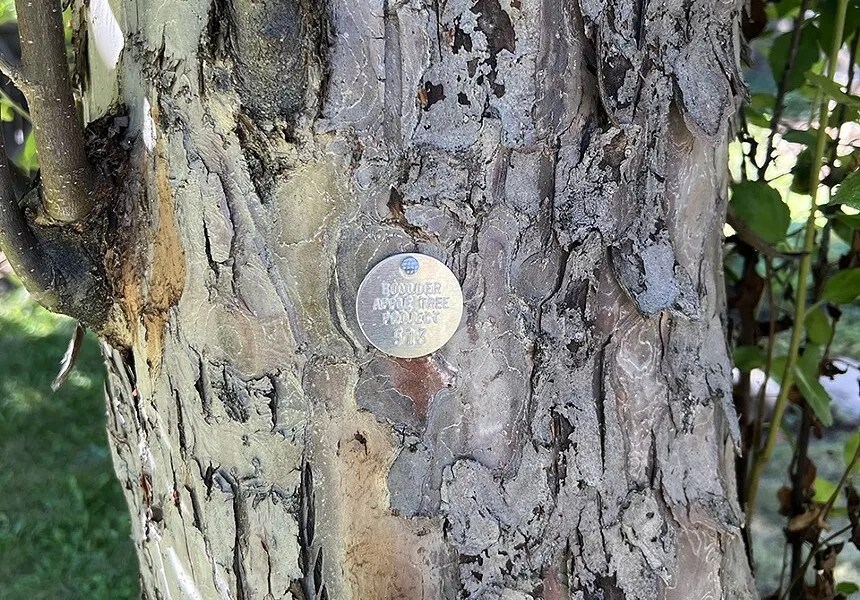
The tree on Carol Taylor’s property that was examined by students during the 2021 “Apple Blitz.”
Evan Semón Photography
James Luby is a professor at the University of Minnesota and one of the leaders of the school’s apple-breeding program – where Dunbar-Wallis believes the Eldorado tree came from. “Both Wealthy and Grimes Golden were very popular varieties back in the late 1800s, early 1900s,” Luby says, noting that the Wealthy cultivar was actually created in Minnesota and used often in the university’s breeding program. “Wealthy – it was like a superstar variety of its time and recognized as being quite winter-hardy…so it would have been known as something that might succeed [out west]. So then you send some seeds out to, you know, your former neighbor, your brother or sister who moved out there, and they take off.”
Another Boulder Apple Tree Project tree, which Dunbar-Wallis identifies as “498,” was also found near Eldorado, on land that’s been in the Pruden family for four generations.
“We connect with historians and local historical societies, and they’re able to tell us about the families and where those families came from,” says Dunbar-Wallis.
According to the CU Boulder Museum of Natural History, Jennie Margaret Hogan Pruden came to Boulder in 1882 and kept a detailed diary of her life from 1891 to 1946. The family built a house on property in south Boulder in 1891; between 1891 and 1898, Margaret and her husband, Charlie Pruden, planted 115 trees. The apples “were generally small – not bad-tasting, but not delicious,” grandaughter Cherry Moore told the museum. “I mean, they weren’t premium apples. With the exception, there was one tree out there. It was kind of like the tree in the Garden of Eden. It was a Golden Apple, and it sat right out there. And it was everyone’s favorite.”
Like Moore, many people are happy to share history. “People are really interested,” Suding says. “They have a tree. It’s going to die soon, but they love that tree. ‘This was my grandma’s tree; she made applesauce.’ There’s a lot of interest, because people are attached to these old trees. But these [new ones] kind of carry on, because they’re the same tree.”
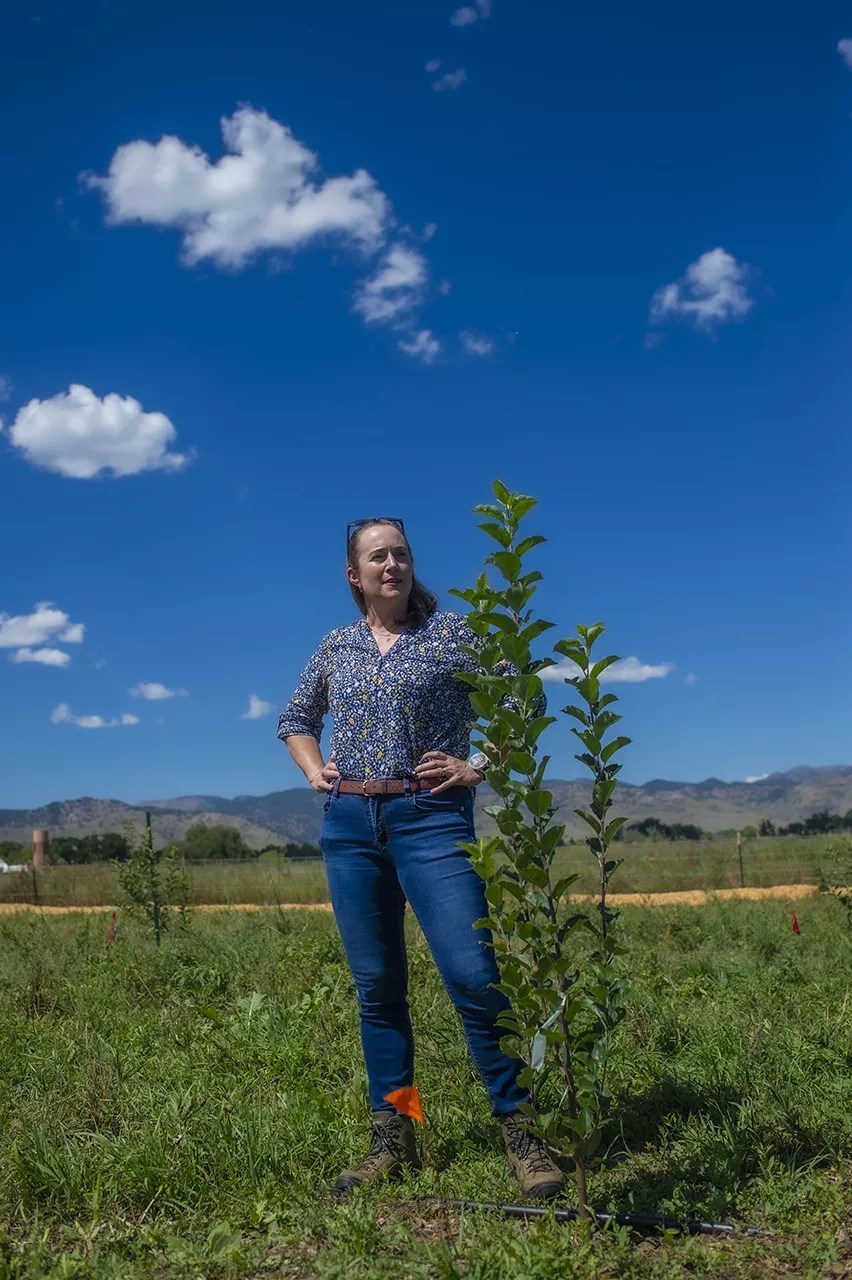
Amy Dunbar-Wallis stands by a recently planted apple tree in the orchard she oversees.
Evan Semón
As Suding’s small team of researchers began cataloguing apple trees, they soon realized how big the job would be. “All of a sudden it was totally clear that these are not just limited, unusual cases. They are all over the place,” she says. “After 2017, we realized that there were far more trees than a couple of people can go sample.”
So in 2018, the Boulder Apple Tree Project started what it called the “Apple Blitz.” The blitz takes place every fall and involves researchers and community volunteers going out to hunt for more lost apple trees. “We send all these teams out to record and try to tag and do as much as we can to document all these trees,” Suding explains.
In 2019, CU Boulder began offering an undergraduate science course – EBIO 1250: Introduction to Research – that works with the Boulder Apple Tree Project, and the blitz is one of the first big events of the semester. “The students love it because they’re kind of like the experts,” she says. “And the community is really interested because…a lot of people want to know about particular trees.”
Boulder resident Carol Taylor invited the Boulder Apple Tree Project to check out her apple tree during the 2021 blitz. “When I heard about the Apple Tree Project, I was like, ‘Oh! I need to find out more about my tree and where it came from,'” she recalls. Taylor lives just north of Chautauqua Park and thinks that her tree is at least sixty years old based on the age of her house.
CU Boulder students and a project staff member “came over, and they all looked at the tree [and] took notes,” she recalls. “The tree had a lot of apples at the time, so we took some apples; they cut [them] up and took some seeds. They all tasted the apples, and they had a little chart about the flavor of the apple and the texture, so they recorded all of that.”
She adds that the apples are “absolutely just delicious. They’re a little bit tart and crunchy.”
“This is a quite tall tree at over 30 feet tall and a large canopy of ~23 feet!” Dunbar-Wallis notes today. “At the time of tagging, this tree had abundant green/red fruits that were considered quite tart to the taste.”
Before the researchers left, they nailed a small silver plaque to the trunk: “Boulder Apple Tree Project // 513.”
Taylor’s tree has not yet been “DNA fingerprinted,” according to Dunbar-Wallis, but the project has “dried leaf material for when we are able to pick that up again.”
CU faculty member Lisa Corwin teaches the class, which gives students a chance to do fun, important scientific work early in their education, as opposed to the slightly less exciting and more standard scientific education that undergraduates usually receive. “It’s a type of class that we call a course-based undergraduate research experience,” Suding says. “The premise is that if you only do cookbook stuff when you learn about science, and the answer is already known and you just have to [follow a] list and see if you get the right or wrong answer – all that interest about having a question that you want to figure out and be creative and stuff like that, you kind of lose that in biology until you’re almost done with your degree.
“So starting early and saying, ‘Actually, we don’t know about these apple trees; let’s figure it out,’ you get to have an authentic research [experience] right from the start,” she says. “It’s the idea that that could be first, and we can give you lectures and teach you about how photosynthesis works later. But it’s that discovery – that’s the thing to start with.”
The project also works with other colleges and community colleges throughout the state, including Front Range Community College and Fort Lewis College.
As the Boulder Apple Tree Project grew from mapping and cataloguing trees to cloning and preserving trees, it needed room to grow. While it stores all of its grafted and cloned trees in a greenhouse, Suding and her team thought it was time for the project to have an orchard of its own.
Last year, it found just the place for it: a little triangle of land in north Boulder just off of CO 119 owned by City of Boulder Open Space.
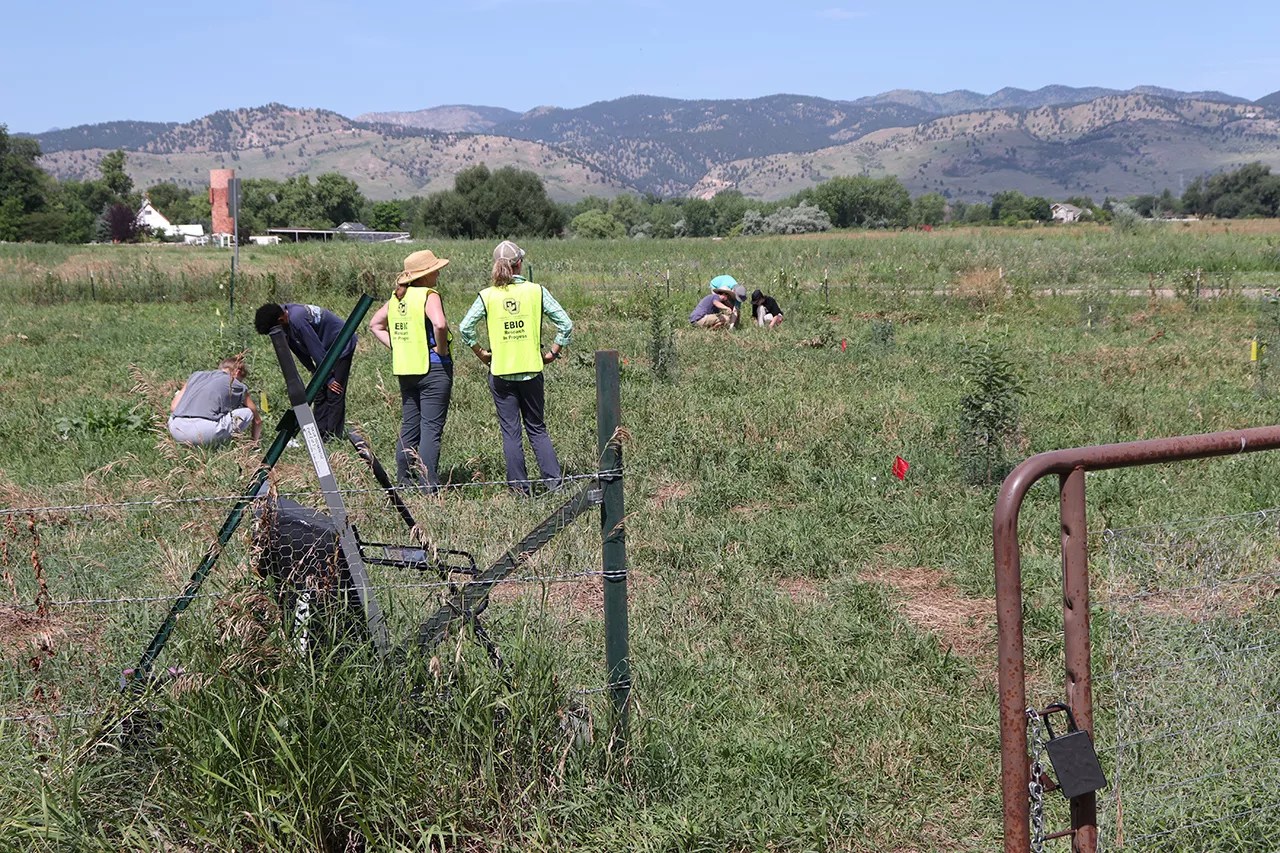
Amy Dunbar-Wallis and Katharine Suding work with CU students at the Boulder Apple Tree Project orchard.
Benjamin Neufeld
“This is an agricultural lease, but it’s a really small piece of property, so it’s not likely that someone’s going to want to put a farm in here,” says Dunbar-Wallis. “But Boulder County Open Space wanted the land to be used, and we’ve been working with them since 2018, and they thought it would be a great way to bring in all these trees.”
“I think it’s a really cool project,” says Mary Tiernan, an arborist for Boulder County Parks & Open Space. “We’ve been acting as facilitators to get them access to trees that they otherwise wouldn’t have been able to access. They’re really awesome people to work with…full of cool little tidbits about the trees.”
Dunbar-Wallis and other project members surveyed the orchard land last fall. “For a long time, this was prairie dog habitat, and last year, Open Space relocated all the prairie dogs,” she says, adding that at that point, “it was mostly dirt.”
The project planted grafted tree saplings on the land on May 1, when it “was still mostly dirt,” says Dunbar-Wallis. But then came all the summer rain, and because “the ground had been tilled so much by the prairie dogs, everything grew up, and this space worked really hard at being a wetland. So for about a month, we had lots of toads, we had lots of redwing blackbirds nesting.”
And grass, “grass up to our shoulders” that was taller than the baby trees, she adds. Boulder Open Space mowed the grass, but it wasn’t easy. “We had put cages around each of the trees, and we had a map that we gave to Open Space so they knew exactly where all the trees were,” Dunbar-Wallis says. “That was really scary, actually.”
Now, despite some minor issues with insects and weeds and one more major incident involving deer breaking in and eating the tops of some specimens (Dunbar-Wallis quickly replaced them with backups from the greenhouse), the trees are in great shape. “I would say the trees have doubled in size since May 1,” Dunbar-Wallis reports.
While the trees won’t bear fruit for at least a couple of years, the Boulder Apple Tree Project team hopes to eventually turn the orchard into an open and interactive educational opportunity for students and community members alike.
“We want this to be a highly accessible orchard space so that folks from different situations are able to access the trees,” Dunbar-Wallis says. “Folks will be able to learn about their local food source; they’ll be able to learn about grafting; they’ll be able to learn about genetics of trees, local and native wildflowers. This is going to be an outdoor classroom for lots of different folks.”
“We want this to be a highly accessible orchard space so that folks from different situations are able to access the trees.”
“That’s a little less ivory-tower than something like fruit flies in a lab,” Suding adds.
Part of the science project involves determining the best way to run an orchard that preserves historic apple trees. As part of this research, different types of “understory plants” have been planted near and under trees, to see which ones have the most positive effects.
“This can be kind of like a laboratory, as well as a place that people can walk in and look for themselves,” Suding says.
Trees now growing in the orchard include a Ben Davis, a historic tree that was commercially popular at the turn of the twentieth century but eventually lost favor. Another – “our rock star of the bunch,” according to Dunbar-Wallis – is the Colorado Orange, another once-popular apple cultivar created in Colorado and thought to have gone extinct after the Red Delicious craze.
In 2019, the Montezuma Orchard Restoration Project, another apple tree restoration effort that was founded in southwestern Colorado back in 2008, managed to track down a Colorado Orange cultivar in Fremont County that was barely alive.
Despite the lack of a genetic match in any apple database – because that kind of technology was not available when the Colorado Orange was lost – matches with descriptions and models of the Colorado Orange made the project’s researchers confident in the rediscovery.
Like the Colorado Orange, many trees in the Boulder Apple Tree Project’s orchard do not have any genetic match in any record of apple cultivars. Some may only be known to the families that cultivated them; others may never have been catalogued, or simply escaped the notice of the busy state horticulturist in the 1920s. But even if a tree made that catalogue a century ago, without a genetic record, it’s impossible to say for sure whether any of the project’s discovered trees are actually rediscoveries of the state’s 200 missing cultivars.
For now, those unidentified trees are referred to by a number – like tree 498 on the Pruden property. But soon, working with other apple restoration efforts throughout the country, the Boulder Apple Tree Project plans to come to a consensus on how to name (or rename) unidentified trees.
“Say the next generation, or two generations from now, of apple explorers come along, and they want to know what a tree is,” suggests Dunbar-Wallis. “They can better follow the breadcrumbs, so to speak.”
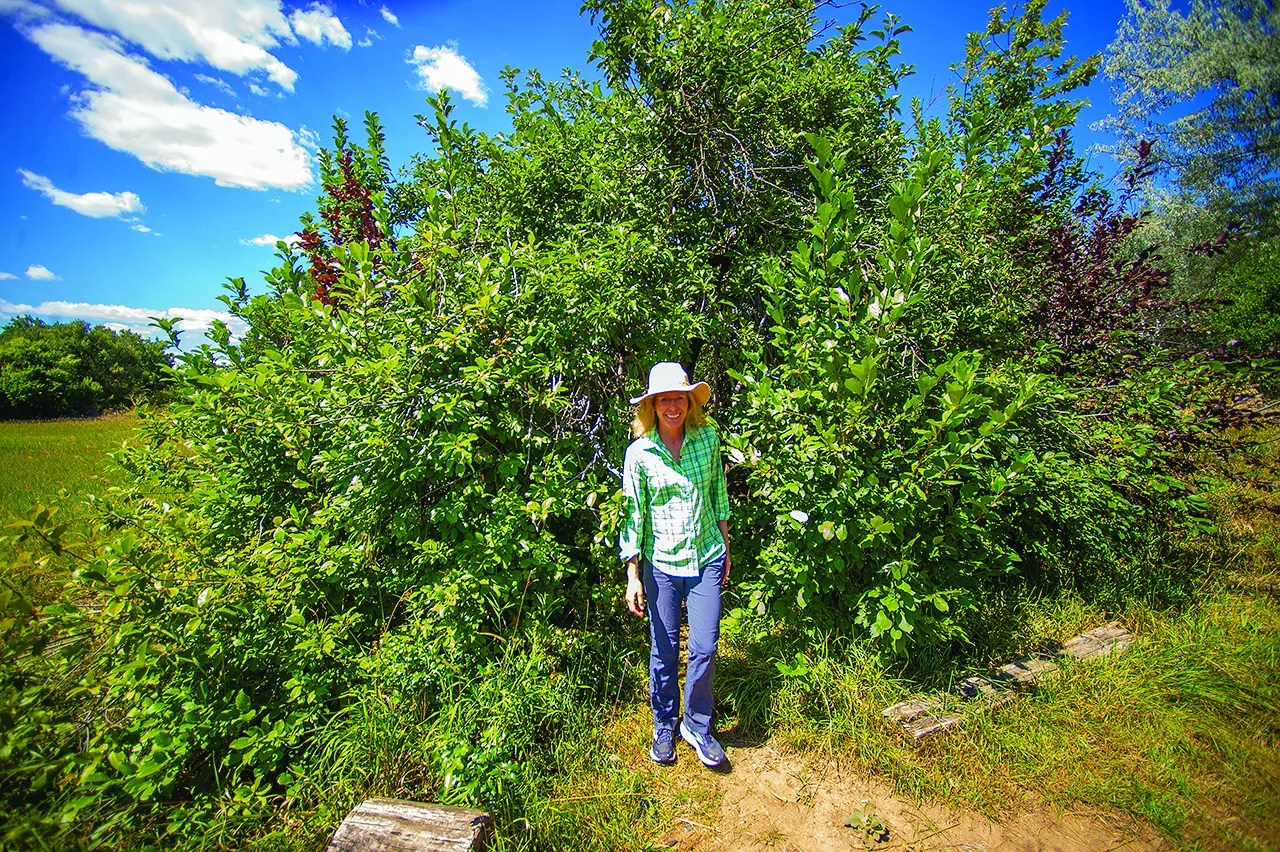
Katharine Suding by the tree that started it all.
Evan Semón
The old tree is still in the field by Suding’s house. “Its main trunk has fallen,” she says, “but side branches are alive and producing fruit” – as are apple trees across Colorado at this time of year. “The apples are not the best-tasting apples in the world,” she admits. “Very tart and acidic, green.”
But they inspired a project that’s preserving Boulder County history, one tree at a time.